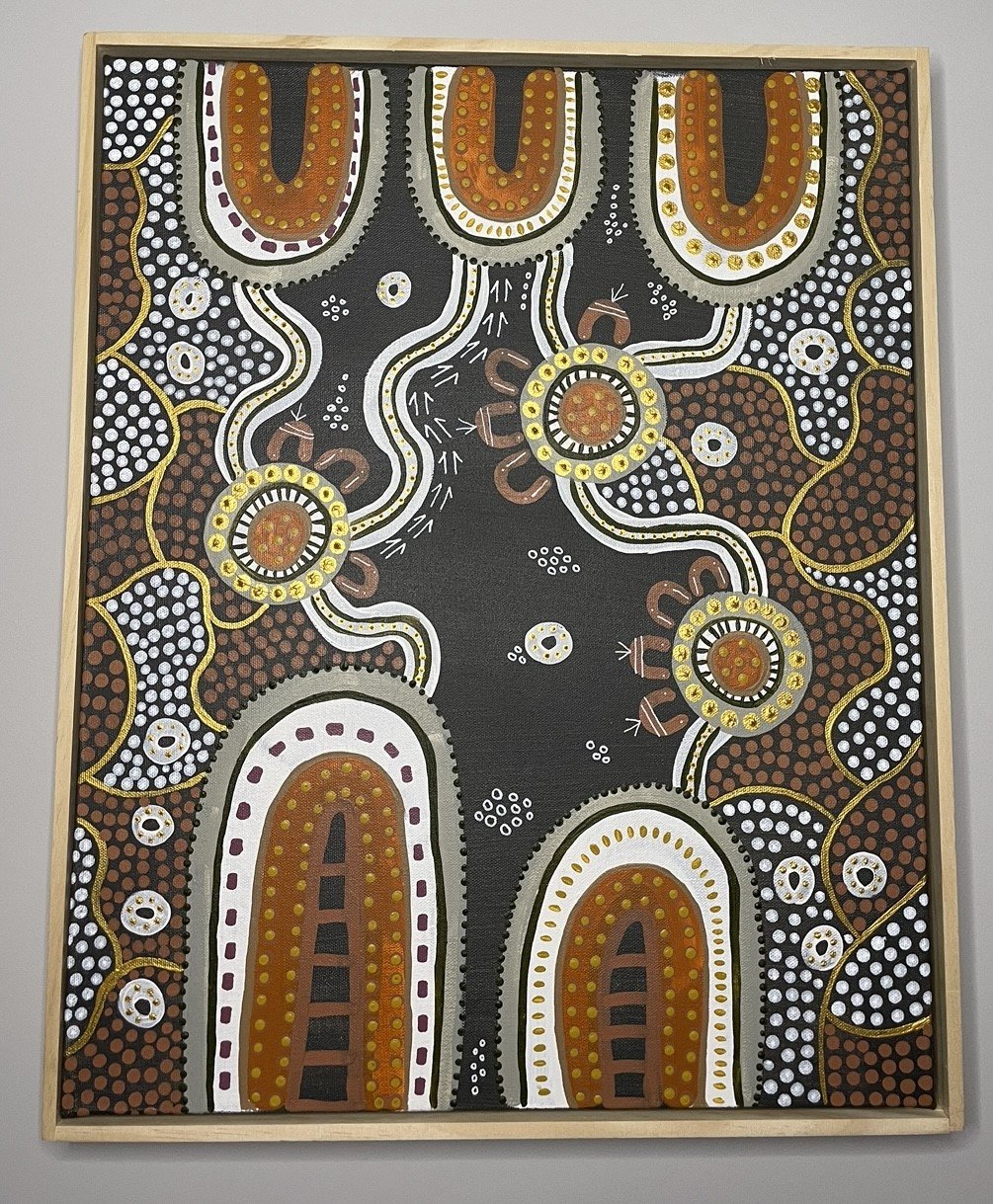Tara Robinson
“Songlines”
Acrylic on Canvas
42.5 x 52.5 cm
$1000
Songlines, also known as Dreaming tracks or Dreaming paths, are ancient Aboriginal cultural narratives that weave together the creation of the land and its inhabitants with the journeys of ancestral spirits. Passed down through generations, these songlines are a sacred part of Aboriginal tradition, serving as maps and stories that connect people to their ancestral roots and provide guidance for their lives.
Tara Robinson
“Spiritual Elders of Knowledge”
Acrylic on canvas
52.5 x 42.5 cm
$1000
Paying our respects to Aboriginal spiritual elders is a fundamental act of acknowledgment and gratitude for their invaluable wisdom and guidance. These revered elders carry the ancestral knowledge and traditions that have been passed down through countless generations. By recognizing and honouring their role, we not only show reverence for their spiritual insights but also acknowledge the resilience and strength of Aboriginal cultures. Through their teachings, these elders connect us to the ancient wisdom of the land and foster a deep understanding of the interconnectedness between humans, nature, and the spiritual realm. By listening and learning from them, we enrich our lives and contribute to the preservation of their invaluable heritage.
Tara Robinson
“Sacred Ochres I”
Acrylic on canvas
33 x 33 cm each
$650
Sacred ochres hold profound cultural significance in Aboriginal culture. This interpretation of the natural pigments, derived from minerals and clays, have been used for thousands of years by Indigenous communities for ceremonial and artistic purposes. Furthermore, ochre's mapping significance cannot be overlooked. Indigenous communities used ochre to mark significant landmarks, sacred sites, and travel routes on maps or directly on the land itself. These intricate markings acted as navigational aids, guiding individuals and groups through vast territories. Ochre-infused maps became living records of ancestral journeys and held essential information for hunting, gathering, and ceremonial practices. By appreciating and respecting the cultural importance of sacred ochres, we honour the deep heritage and profound spirituality woven into indigenous cultures, fostering cross-cultural understanding and appreciation for the artistic expressions of diverse communities.
Tara Robinson
“Sacred Ochres II”
Acrylic on canvas
33 x 33 cm each
$650
Sacred ochres hold profound cultural significance in Aboriginal culture. This interpretation of the natural pigments, derived from minerals and clays, have been used for thousands of years by Indigenous communities for ceremonial and artistic purposes. Furthermore, ochre's mapping significance cannot be overlooked. Indigenous communities used ochre to mark significant landmarks, sacred sites, and travel routes on maps or directly on the land itself. These intricate markings acted as navigational aids, guiding individuals and groups through vast territories. Ochre-infused maps became living records of ancestral journeys and held essential information for hunting, gathering, and ceremonial practices. By appreciating and respecting the cultural importance of sacred ochres, we honour the deep heritage and profound spirituality woven into indigenous cultures, fostering cross-cultural understanding and appreciation for the artistic expressions of diverse communities.
Tara Robinson
Roots of Connections
Acrylic on Canvas
Round 75 cm
$2000
“Roots of Connection” explores the deep connections between Aboriginal and Torres Strait Islander Ties to Land, Community, and Spirit". Searching for connections to the roots of the peoples and land, where every rock, river, and tree hold ancestral stories. I try to represent the vibrant cultures and diverse traditions that flourish within these communities, capturing the essence of respect for nature and the interconnectedness of all living beings.
Tara Robinson
Tara Robinson a proud Aboriginal and Torres Strait Islander contemporary artist. Have lived on Gubbi Gubbi / Kabi Kabi Country for most of my adult life, My cultural connection is from my mother's side - grandmother Ah wang family from Badu Torres Strait Islander / Malaysia and my grandfather Frazer Mob from Cherbourg. And I would love to acknowledge my father with our English, Scottish and Irish heritage. As a young child my parents travelled Australia a lot and I grew up on lots of different remote communities, one being Pitjantjatjara country were I first learnt about traditional Aboriginal art. Through my art I am passionate about expressing stories and exploring themes of heritage, spirituality, and connection to land. One of the greatest expressions of my artworks is that it really represents my culture, about being on country, touching the earth, walking alongside it with our people and our animals, the sound of the sea, and that spiritual connection to our elders and our history. I am humbled by the recognition and appreciation my work has received. It is my hope that through my art, I can inspire dialogue, promote cultural understanding, and leave a lasting impact on those who engage with my creations. My dream is to be a bridge between the past and the present, tradition and innovation, while also creating a space for future generations of indigenous artists to explore their own creative paths. Together, let us celebrate the enduring spirit and resilience of Aboriginal and Torres Strait Islander art, and the power it holds to connect and inspire us all.






